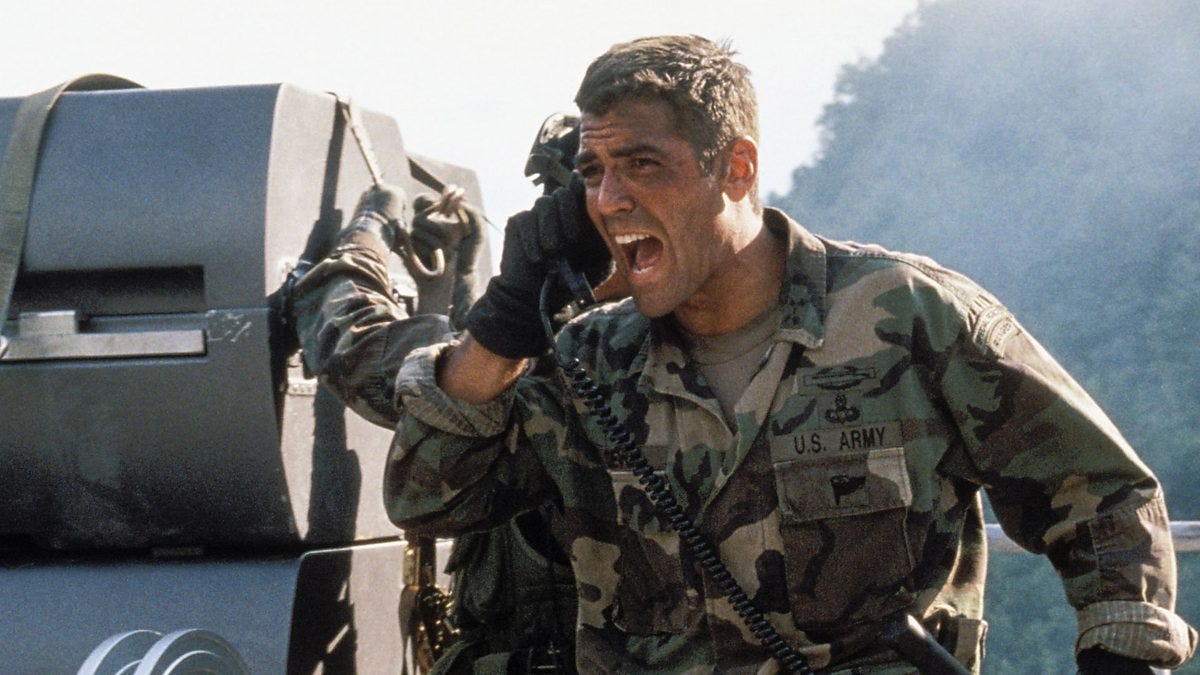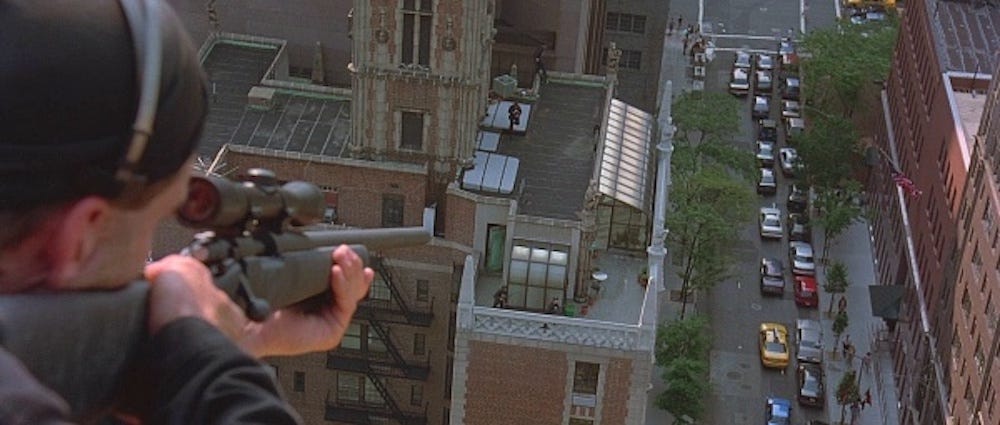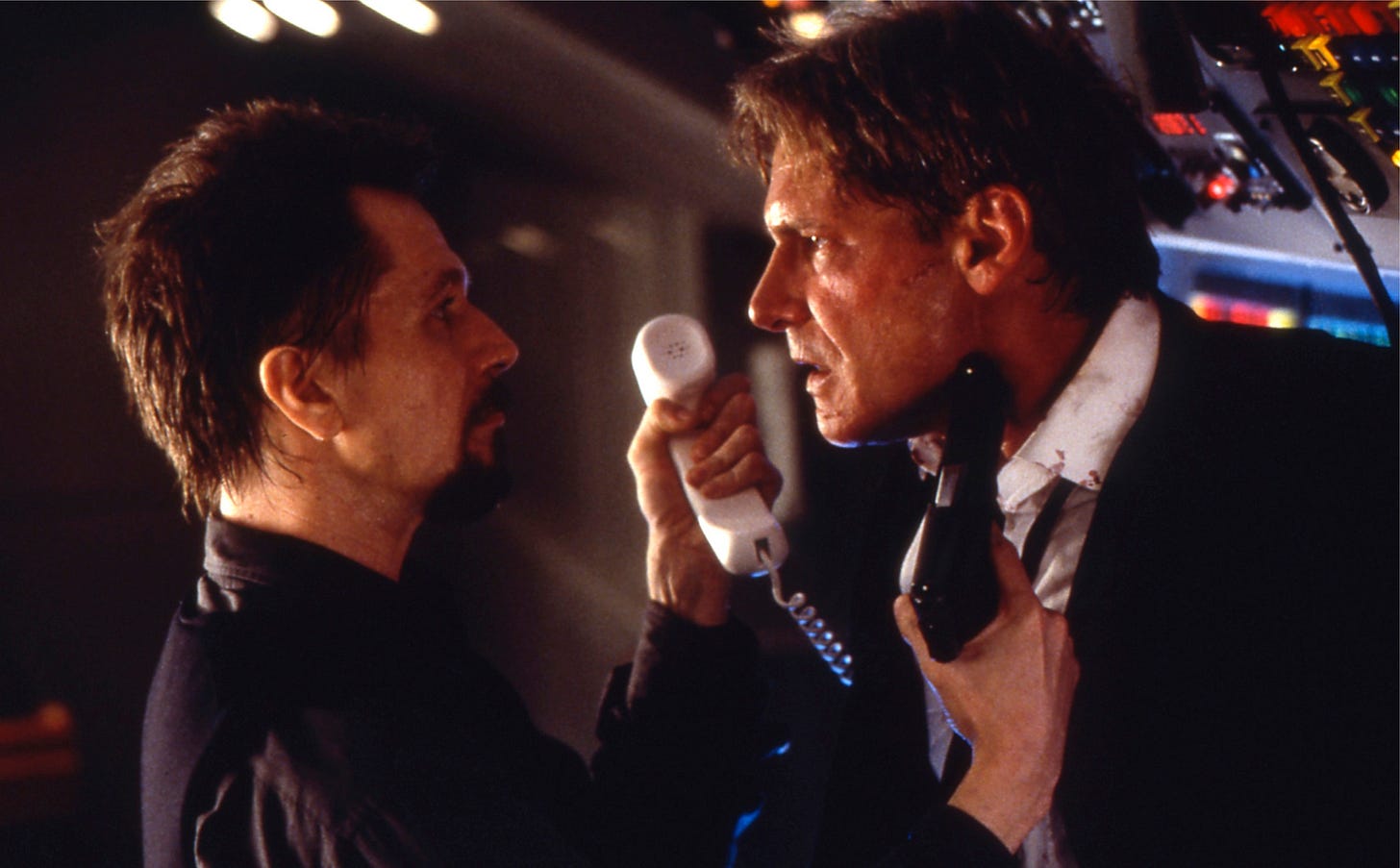They Make a Desert and Call It Peace
On Mimi Leder's 'The Peacemaker' (1997), Pax Americana, and the End of History
The political and military thrillers of the ‘90s reckoned with a change in the zeitgeist so vast it was almost hard to see from the ground. The great adversary, the Soviet Union, had loomed over American studio filmmaking for half its history, inflecting and defining some of the most important film productions of the twentieth century, generating subgenres and narrative tendencies which felt — like the Cold War — as though they would never really leave. Infamously, the American military-industrial complex faced an existential crisis of identity upon “winning” the war and losing their raison d’être, and scrambled in the early part of the decade to find a new justification for permanent war footing in a unipolar world. It’s fitting, perhaps, that Hollywood studio filmmaking, so often the handmaiden of military patriotism and its various shareholders, would show signs of the same frantic scramble for purpose, the same blind search for the narrative shape of this new reality. The collapse of the USSR, combined with the ephemeral but blinding prosperity of the Clinton years, created in the blink of an eye a new world which felt like it must last forever; and new worlds, however seemingly peaceful, are never easily charted.
Movies about war have always been a key part of how America talks to itself: the Vietnam War films of the New Hollywood era held a mirror (however incomplete) to the defining trauma of a generation, while movies like First Blood (1982) and the ensuing Rambo series redefined American colonial warfare for a newly revanchist national mood. And The Peacemaker, Mimi Leder’s modestly successful, indifferently received 1997 George Clooney-Nicole Kidman vehicle, is a movie about war, even if the title speaks only of peace, even if no formal hostilities are ever declared. It’s a movie about America’s new kind of war, the kind of war you fight when your enemies have already been defeated, and about the defense contractors, bureaucrats, and soldiers of fortune who rule this new world unchallenged. It’s about war at the End of History, about war beneath the banner of unipolar peace, and it’s a deceptively fascinating — if notably deranged — contribution to a filmic conversation which was far from resolved when events at the turn of the century redirected it forever.
Its inciting incident capitalizes on one of the great bogeymen of the 1990s: the former Soviet nuclear arsenal, which loomed large in the American consciousness as a potential playground for terrorists and paramilitaries running riot in a region transformed by political collapse and U.S.-abetted gangster capitalism. The seizure of dubiously-controlled Soviet weaponry by a rogue Russian general is the basis for 1995’s excellent GoldenEye, and as late as 2000 an episode of unrivaled ideological showcase The West Wing could stoke these same anxieties with an A-plot about a suspicious fire in a Russian nuclear silo. Here, as in GoldenEye, it’s a rogue Russian general who absconds with nine Soviet warheads after detonating the tenth as misdirection, though he has no grand plans, no ideological axe to grind; he simply wants to sell these weapons to Iran. He’s one of the amoral middlemen who will feed on this new world if not restrained by force, the venal creatures who thrive in the anarchy only American arms can prevent.
If the titular Peacemaker of the film is one of its protagonists — though, as I’ll discuss below, the film ultimately suggests otherwise — it’s likeliest to be Nicole Kidman’s character Julia Kelly, an interim head of the NSC Nuclear Smuggling Group tasked with tracking and recovering the missing bombs. Dr. Kelly represents not only the arcane security bureaucracy that manages the Pax Americana, but also the revolving door this bureaucracy shares with the defense industry. For the later narrative purposes of the film, but also for my rhetorical purposes here, it’s almost too perfect that her background is in research and development for an arms manufacturer; in one of their first slightly barbed exchanges, George Clooney’s Thomas Devoe asks her if she’s dedicated to blowing up the world or saving it. “I believe this week we’re saving it,” she replies. Marvelous.
Lieutenant Colonel Devoe is her military liaison, an Army Ranger with a vaguely-defined brief first seen defending himself from interrogation about something that might have been a hush-hush exchange of luxury goods for official favors or might instead have been simple black-market commerce. In Devoe’s world the distinction is not especially material; he operates almost entirely outside the law, bribing Russian fixers and torturing Austrian trucking magnates as the business of state requires. One extended sequence in Vienna, which culminates in a thrillingly destructive car chase — precisely and propulsively filmed by Leder — could have been lifted straight from a spy thriller, Devoe as the icily competent and experienced field agent, Kelly as the civilian trying desperately to survive in his world. It represents, in fact, a fascinatingly precise halfway point between a James Bond film like GoldenEye and one of the Bourne movies, with its emphasis on kinetic action, and on the kind of structured outlawry that exists at the margins of formal geopolitics. It’s one of The Peacemaker’s several inchoate ideas that would emerge fully-formed in the very different world of the 21st century.
To the extent that there is a character arc in the film, it involves Kelly learning to act more like Devoe, and Devoe learning to think more like Kelly. The situation is simple, he tells her at first: she works for the good guys, and the bad guys are everywhere. “They don’t wear black hats,” he says. “They are, however, all alike.” They want money and respect, and they need to be stopped. She protests that there are other motives, rage and hate and pain, more difficult to meet with force; events will prove her right, but for now the film is still aligned with Devoe’s view of the world. Before long he’s looking for her authorization to undertake a mission into Russian territory, where the warheads might be reachable for the last time before they disappear into Iran. This is a flagrant violation of Russian sovereignty, and even the President understands that the result might be war, but the Russians lack the capacity to intercept the warheads in time, so the responsibility falls to America, whatever the consequences. In this new world the United States has no true allies, no true rivals; if real action is to be taken it’s we who must take it. Kelly makes the call. Devoe goes in, and the warheads are recovered. At the cost of nine American lives — one, as it happens, for each of the missing bombs — the day and the world are saved.
Except not quite. Another facet of the post-Soviet order, dangled elliptically in the film’s opening scene, now re-emerges to turn the situation on its head: the Yugoslav Wars, the ravages of which have produced a pair of would-be terrorists from Sarajevo, now attached to a UN peace delegation. They’ve taken possession of the final missing warhead and taken advantage of their diplomatic status to smuggle it into the United States, where they intend to destroy the United Nations (and with it, much of Manhattan). One of the two, a sensitive classical pianist, records a video for posthumous release declaring that he’s not a monster; he simply wants revenge against the foreign powers who have flooded his region with arms, transformed it into a hellscape, and cost him the lives of his wife and child. This is blowback, generated not just by U.S. foreign policy but by precisely the kind of company Kelly used to work for, the people who enriched themselves creating the very weapon that now threatens millions. The depravities of the Pax Americana have come home.
The climax of the film sees the pianist, warhead on his back, evading first a dragnet set by Devoe and Kelly, and then, finally, a foot pursuit from Devoe and Kelly themselves. It’s a taut, engrossing sequence highlighted (if that is the word) by a moment of eyebrow-raising utilitarian commitment: a sniper, coordinating with Devoe, reports that he has the pianist in his crosshairs, but that a family with a small child is in the way. “Acknowledged. Take the shot,” barks Devoe, who repeats this command with increasing urgency and frustration as we watch the sniper wrestle with his conscience and his orders, the oblivious smiling toddler still squarely in his sights. In the end the shot isn’t taken, but there’s something shocking about the film’s suggestion that perhaps it should have been; after all, what’s one child’s life when millions are at stake? This is a logic that would be endlessly invoked in the years after 9/11, the kind of literal apocalypse scenario that would come to power shows like 24; amidst the heady derangement of the early aughts, op-ed readers and audiences alike thrilled to this kind of amoral calculus and the men like Devoe who perfected it. Here it’s slightly incongruous, the kind of utter ruthlessness the genre cannot yet comfortably wear. I guess you guys aren’t ready for that yet, the film seems to say; but your kids are gonna love it.
The foot chase ends in a church, the pianist fatally shot, the bomb in his backpack already counting down to detonation. He articulates his sense of pain and loss, his feeling that the arbiters of the global geopolitical order are responsible for the chaos that destroyed his family. He asks who pays for the ravaging of his country, for the deaths of his wife and child. “Sir, it’s not our war,” Devoe responds, not especially sympathetically. “It is now,” says the pianist, and shoots himself to death. It’s an exchange that encapsulates the thesis of the film: every war is now America’s war, every threat to peace and stability anywhere is a danger to civilians here. The project of national “defense” must turn outward if it is to keep the little wars of the world from coming home. And they will. By sheer force of gravity, there’s nowhere else left for them to go.
This is a vision of the world that would not really cohere until 9/11, intelligible in retrospect as an origin story of sorts for the World Trade Center attacks. In this vision, the world beyond our borders is dangerous, anarchic, filled with weak and atrophied nations whose inevitable failures of state capacity will empower terrorists and strongmen no regional power can check. The deep-state denizens and trumped-up assassins this film centers are to be understood, in the context of this later political imaginary, as unsung heroes, extending U.S. power into places nobody cares about so that nothing can happen to the places that matter. These were not ideas new to the genre in 1997, of course; the post-Cold War Tom Clancy novels and their successful adaptations (1992’s Patriot Games, 1994’s Clear and Present Danger) had already begun to explore a world of new and varied threats to national security, and Air Force One (1997), released two months before The Peacemaker, dealt with the threat of nationalist movements in the nuclear lawlessness of the former Soviet bloc. But The Peacemaker is anomalous in its scope, in its explicit conviction that the smaller stories told by these other ‘90s films were all really the same story, happening everywhere at once.
In part for this very reason, critics were lukewarm in their response to the film, whose box office receipts constituted a tepid (though not disastrous) beginning for debutant studio DreamWorks. Leder’s direction was rightly appreciated, as were Kidman and Clooney’s performances, but the narrative struck critics as trite and politically muddled, and more than one expressed exhaustion at the film’s rapid movement between settings. This globetrotting structure — eminently conventional, of course, for a spy film, but perhaps not for the kind of thriller this seemed, in its moment, to be — can be regarded as a political statement in itself; the hostile world Kelly and Devoe navigate has no single center of gravity, no single forward base from which to confront the threat. The film is politically incoherent, if what you want is a causal explanation for the world it depicts, a robust sense of what might drive non-Americans to fight. But the worldview of The Peacemaker looks everywhere but back: there are fires burning all around, and someone has to put them out before they spread. The threat is everywhere, until it’s here.
In the end, Kelly successfully defuses the bomb, turning her expertise as an arms manufacturer into an instrument of salvation. Despite this achievement, however, the film does not — as I noted above — seem to present her as the film’s titular Peacemaker. That word appears only in the pianist’s video, as he decries U.S. and UN “peacekeeping” efforts in his country: “We can never accept a peace that leaves us with nothing but pain. Pain the ‘peacemakers’ must be made to feel.” From this Devoe and Kelly infer the pianist’s intention to target the UN and its peace delegations. Why, then, is the title in the singular? One Peacemaker, not many? An argument might be made that it refers to the pianist himself, who after all belongs to a peace delegation, or to the assassinated Yugoslavian moderate whose place on the delegation he assumes; this would give the title a certain irony, a pleasing sense of double entendre. In this same ironic spirit we could conceive of the bomb itself as the titular force, the nuclear weapon as promised deterrent, the weapon to end all wars; the Peacemaker, now come to bring the kind of “peace” that drove the pianist on his mission of vengeance.
But I like to imagine the film’s Peacemaker as the United States, the last superpower standing, longtime overseer of a Pax Americana now imagined — in the dumbfounded world of the 1990s — to be reaching its ultimate fruition. This too would be a title with a sense of grim irony, richer and grimmer with each passing year. The Pax Americana, of course, took its name from an earlier proclamation of Roman peace, one as bloody and contradictory in practice as ours, as symbolic of brutal hegemony and blinkered noblesse oblige. Even some contemporaries knew to be skeptical of the Pax Romana, or at least knew what shape that skepticism might take, and from one comes a famous turn of phrase that might have been quoted by The Peacemaker’s doomed pianist, imagining the ruins of his country: “Where they make a desert, they call it peace.”









